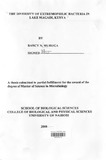| dc.description.abstract | Lake Magadi, a highly saline lake with a pH range of about 11 to13, harbors extremophilic
eubacteria and archaeobacteria that are either halophilic, alkaliphilic, haloalkaliphilic or
thermophilic. Water sampling was done in seven hot springs along the shoreline and one
sample from along the Western causeway. Physicochemical conditions included a
temperature range of 30°C to 47°C , a pH range of 10 to 10.5, hydrogen peroxide
concentration ofless than 0.5 ppm and dissolved O2 concentration ranging from 1.1 mg/l to
2.9 mg/l. Morphological characterization indicated presence of gram positive and gram
negative bacteria with shapes varying from rods, cocci, spirilla to coccobacilli. Biochemical
characteristics of the isolates included catalase production and hydrolysis of casein and
starch. The optimal temperature for growth of bacterial isolates ranges from 40°C to 45°C
while optimal salt concentration ranges from 6% to 9% w/v. Successful PCR was done on
genomic DNA from the bacterial isolates, using 16S primers, and verified by means of
agarose gel electrophoresis. On sequencing, four of the PCR products had about 1,500 bp of
16S rRNA. When aligned to existing sequences in the NCBI database, they were found to be
closely related to members of the gamma subdivision of the Proteobacteria with over 98%
similarity. One of the isolates appeared to have a separate lineage from the ones in the
database with only 97% similarity to its closest comparison. Two of the isolates were closely
related to but not identical to members of the genus Halomonas. Phylogenetic analysis by
means of a rooted tree showed that three of the isolates clustered closely with members of
gamma Proteobacteria. The multialignments obtained in this study can be used for primer
design and the characterized isolates can be used to obtain metabolites for biotechnological
applications | en |

